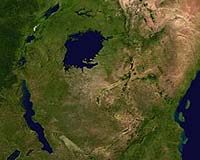| . |  |
. |
Sydney (UPI) Feb 1, 2009 A $1.7 billion desalination plant has opened in Sydney, expected to supply up to 15 percent of the area's water needs. The seawater reverse-osmosis facility in the southern suburb of Kurnell has been driven by concerns about climate change, Sydney's inconsistent rainfall patterns and a rapidly growing metropolitan area that attracts some 50,000 new residents each year. "This is about preparing for Sydney's expanding population. In the face of climate change, in the face of increasing drought, it is important we are securing Sydney's water supply," Kristina Keneally, premier of New South Wales, said during the plant's opening ceremony Thursday. The desalination plant is now producing 55 million liters per day of water, which will gradually increase to full capacity, 250 million liters a day. Water from the Kurnell facility will be distributed to 1.5 million people as part or all of their water supply throughout Sydney. The plant is 100 percent offset by wind energy, and a new wind farm with 67 turbines is now up and running nearby at Bungendore. Officials say coastal ecosystems will not be adversely affected by the salty discharge deposited back into the sea. But John Kaye, a Greens MP in the New South Wales state Parliament, said the construction in Botany Bay had stirred up heavy metals that could harm migrating whales. Other sea life, he said, could also be affected by the dumping of saline waste back into the Tasman Sea. "Sydney's desalination plant was a huge mistake," Kaye told the BBC. "The historical records show we did not need it. The government says it is all powered by green energy, but that could have been used to offset coal generation elsewhere," he said. To achieve desalination at Kurnell, seawater is drawn into the system via a large 2.5-kilometer underwater tunnel. After gravel, sand, silt, seaweed and other debris have been removed, high pressure pushes the water through membranes small enough to capture the salt in a process known as reverse osmosis. The desalinated reserves are then re-mineralized and slightly carbonated, while chlorine and fluoride are added, before being pumped directly into the city's main supply. Keneally said the project would add about $100 a year to the average person's water bill, which would allow the plant to be fully paid off in four years. "By 2025, global demand for water is predicted to grow by over 40 percent," she said. "Along with dams, recycling and water efficiency, desalination is one of four key ways to ensure Sydney has enough water in the future."
Share This Article With Planet Earth
Related Links Water News - Science, Technology and Politics
 Beijing promises 'constructive' role in African Great Lakes
Beijing promises 'constructive' role in African Great LakesKigali (AFP) Jan 27, 2010 Senior Chinese official Zhai Jun told Rwanda's President Paul Kagame in talks here that Beijing is ready to play a wider role in regional security, Radio Rwanda reported Wednesday. "As a permanent member of the UN security council, China is ready to play a constructive role in promoting sustainable stability and security in the Great Lakes region," said Zhai, an assistant foreign minister. ... read more |
|
| The content herein, unless otherwise known to be public domain, are Copyright 1995-2010 - SpaceDaily. AFP and UPI Wire Stories are copyright Agence France-Presse and United Press International. ESA Portal Reports are copyright European Space Agency. All NASA sourced material is public domain. Additional copyrights may apply in whole or part to other bona fide parties. Advertising does not imply endorsement,agreement or approval of any opinions, statements or information provided by SpaceDaily on any Web page published or hosted by SpaceDaily. Privacy Statement |